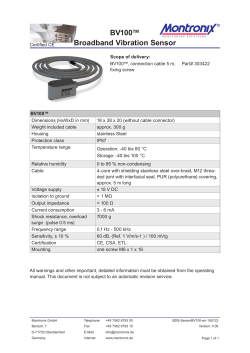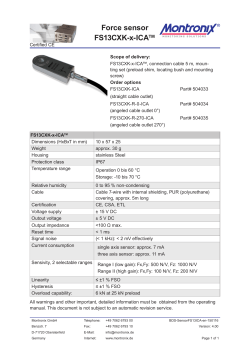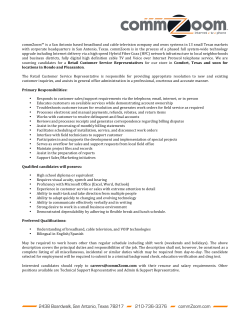
Example # 1. Find the tension FT in the horizontal cable. 40° FT
Example # 1. Find the tension FT in the horizontal cable. 40°° FT = ? 58.0 kg Example #2. In this case, the left cable is strong, but the right cable can only handle a maximum tension of 5.0 x 102 N. What is the heaviest weight that can be hung? 60°° 25°° ? Example #3. A large mass of 50 kg is supported on the end of a rope and the rope is pulled back by a horizontal force so that the rope makes an angle of 80º with the ceiling to which the rope is attached. Make a forces diagram showing all the forces involved. Use this diagram to calculate what horizontal force is needed to pull the mass out this far. Example #4. These three forces act on a ball, as shown. Find: a) the unbalanced force on the ball; b) the force that needs to be added to cause the ball to be in equilibrium. 2.5 N 5.8 N 4.7 N Example #5. A cable that can withstand a maximum tension of 850 N is strung across two walls. A pulley is placed on the cable, and various masses are hung from the pulley, causing the cable to sag. Through trial-and-error, it is found that the cable can only sag 17°° without breaking. What mass was used to cause this sag? 17°° ? Example #6. Now we’ll take the previous example and vary it slightly. In the case below, the system is in equilibrium. Determine the unknown angle as indicated. ? 45 kg 120 kg Example #7. A smart physics student attempts to lift a heavy crate by using a lever system. She pushes on the lever with a force as shown below. What torque is created by this student? 75 N 28º 3.0 m Example #8. A group of physics students attempt to balance a mobile unsuccessfully. Examine the diagram below and calculate the net torque on the large beam that will cause the mobile to start tilting in one direction once it is hung up. string 13 cm 8.0 cm 24 cm 0.58 kg 0.12 kg 0.17 kg 0.22 kg Example #9: Calculate the net torque acting in the system below. Note that the beam is uniform, has a mass of 0.85 kg, and a length of 6.2 m. 1.0 m 1.4 m 0.16 kg 0.28 kg Example #10. A physics student applies a horizontal force of 480 N in an attempt to move a 150 kg refrigerator, but unfortunately causes the fridge to tip over. Examining the diagram below, what is the net torque that causes the refrigerator to begin to topple over? 0.94 m Fapp = 480 N 1.9 m 1.6 m Example #11. A 5.0 kg uniform bar is attached to the wall as shown below, with a 2.0 kg weight hung in the indicated location. What minimum vertical force is needed to cause the system to be in rotational equilibrium? Example #13. A 8.00 kg uniform beam of length 3.00 m is attached to a wall by a hinge and is supported from the ceiling by a rope which makes an angle of 60º with the horizontal, as shown below. Calculate the tension in the rope that supports the beam. Example #14. The 12.0 kg uniform boom below has a length of 3.40 m. The cable can withstand a tension ‘FT’ of 1850 N before breaking. What is the largest weight that can be hung from the boom in the location indicated? FT 40°° ? 2.10 m Example #15. In the diagram below, the uniform boom has a mass of 25.0 kg and a total length of 6.50 m. If the 150 kg mass hangs 4.75 m from where the boom is anchored to the ground, how much tension ‘FT’ is in the cable that supports this system? FT 150 kg 30°° 47°° Example #16. Two students, Phreddie and Phreida Physics, are carrying Normie Neutron on each end of a 20.4 kg uniform plank that is 3.00 m long. If Normie’s mass is 51.0 kg and he is sitting 1.00 m from Phreida, how much lifting force does each student use to carry Normie? Hint: take the pivot at one end in order to remove the force supplied by one student from the situation. Example #17. What force, applied half way up the block, will just start the 22 kg block tipping? Example #18. A uniform 20.0 kg, 5.00 m-long ladder leans against a smooth (frictionless) wall as shown. Find: a) the normal force of the floor pushing up against the ladder; b) the normal force of the wall pushing against the ladder; c) the friction force between the ladder and the floor; d) the overall force that the floor exerts on the ladder. 60°°
© Copyright 2025











